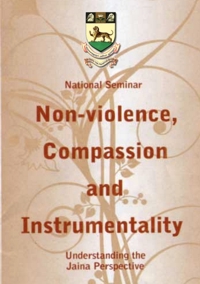 | Non-violence, Compassion and InstrumentalityA Jaina PerspectiveSeminar organized by the Department of Jainology of the University of Madras, 13 and 14 February 2009 Chennai, India |
13.02.2009
1.17 Ahiṁsā
Today we are living in a paradoxical situation. While on one hand modern civilization is characterized by a concern for fellow human beings, on the other hand the foremost problem of our age is growing violence both in thought and action in the individual. On national and international level the crime rate has increased rapidly because of growing greed, intolerance, and other undesirable and unchecked propensities. Above all these, the main reason is ignorance. So let us first know what hiṁsā is, and what ahiṁsā.
Just killing any living creature is not hiṁsā or violence. There are ten life-forces (viz. the life force of hearing, of seeing, smelling, tasting, touching, thinking, speech, action, breathing and living one’s lifespan). To injure, harm or hurt any of the life-forces out of negligence of mind, speech and body amounts to violence. All the life-forces carry equal energy and it is through these life-forces that living beings live and sustain themselves in a physical body.
These life-forces are harmed or injured either with an intention to hurt i.e ‘Bhava hiṁsā’ or with the actual cause to hurt i.e ‘Dravya hiṁsā’. There are four ways. For example;
- Where there is intention as well as the actual cause.
- Where there is intention but no actual cause.
- Where there is no intention but there is actual cause in hurt.
- Where there is neither intention nor the actual cause.
Let us understand through the following examples.
Example 1
A doctor after investigating a patient says to the patient’s family members: “He has to be operated and that will carry a huge amount; are you all ready for it?” The family members agreed, but while doing operation a nerve gets cut off by mistake and the patient dies immediately. The doctor feels guilty and also wept for it. What will you call this type of violence? Did the doctor do it intentionally? No!! He did not do, but it happened. The doctor has committed the dravya hiṁsā and not the bhāva hiṁsā’.Example 2
A doctor purposely operates a patient and tries to kill him, either for money or out of personal rivalry, etc. The case is similar to above example in all respects, except one: He does it intentionally, whereas in the above case he did it unintentionally.Example 3
In the third example, the doctor is very greedy. He has seen that patient has brought a lot of money. After investigating the patient’s body he says, “Your disease is incurable, but even so I will do some effort; rest is up to the gods.”
One day during his treatment he mixes poison with the medicine and gives it to the patient by saying it will cure the disease. The patient takes the medicine. What will happen to the patient? There is a saying in Sanskrit: “Vishasaya vishmaushadam.” Poison itself becomes a medicine to clear the poison. Fortunately the same happened to the sulky patient it became amrit [nectar of immortality] for him and he became well soon. Everyone praised the doctor to cure an incurable disease. Did the doctor commit the violence or not? Yes, there was no actual violence but there was intentional violence (bhāva hiṁsā).Whether it is dravya hiṁsā or bhāva hiṁsā the level of its intensity is the same and it includes three stages: planning, preparation and execution which could be carried out by any one of the three types of media, i.e. the mind, the speech and the body. In the third example you can see all three stages. But since the patient was alive it doesn’t mean there was no execution. There was execution of work, but no fruit is gained by the doctor because the lifespan of the patient was strong and therefore he was safe, but there was too much of violence. Here the act of violence was committed by the doctor himself, but he could have also made someone else do it, for example a nurse, no matter who it will carry the same amount of punishment.
The main reason for any act of violence is passion (anger, deceit, greed, etc.). It was greed, which inspired the doctor to commit the sin. It was not only the greed, but it were also the companions of greed: like anger, conceit, emotion, jealousy, self-centeredness, ignorance, indifference, suppression, carelessness, irresponsibility, etc., which stimulates the one to commit hiṁsā.
This you can see in daily life, the growing violence on children, on students, on servants, on wives and in some cases even on oneself. For instance, we see a lot of child labor coming up these days, whether in factories or at home or at any workplace, and we see that these children are utilized to their full capacities, even though it is forbidden by law. They are paid less and if they do not satisfy their owners they may even be tortured physically and mentally. In this case it is considered to be violence. In other cases we see women who are ill-treated in relation to dowry and in the past [though it even happens today –ed.] even in conditions like sati [suicide in fire of the widow of her passed away husband. –ed.]
These activities which involve violence have to be cut at the roots and for this we as responsible individuals must take steps like setting up organizations for causes like abolishing child labor and rather educating and developing them to be better citizens in the future. There must be steps taken in all societies for equality of rights and opportunities for women and such a work field for the women, which is completely safe and secured. With the few responsible souls who understand the ill effects of violence we must take steps towards making a better tomorrow for the entire world.
 Sramani Shreenidhi
Sramani Shreenidhi